法国阿赛洛钢铁集团专家桥梁学术报告Lectures
桥梁检测报告(右幅)

G11 鹤大公路— K501+545 —得力村中桥(右幅)桥梁按期检查报告桥梁按期检查结论及技术建议桥梁名称K501+545- 得力村中桥(右幅)检查单位检测时间主要病害及原由1、主要病害为:(1)主梁掉角(2)主梁间铰缝沙浆零落(3)桥墩、桥台水迹(4)桥面横向贯穿裂痕(5)伸缩缝拥塞(6)防撞墙裂痕2、病害成因剖析:(1)主梁掉角:初步剖析因为混凝土浇筑后保养不好,棱角处混凝土水分被模板大量汲取,以致混凝土水化不好,强度降低,拆模时棱角被粘掉,出现混凝土掉角现象。
(2)主梁间铰缝沙浆零落:空心板梁铰缝,多为干砌沙浆填补与预制梁粘结性不好,在车辆荷载的作用下以致其零落。
(3)桥墩、桥台水迹:初步剖析因为桥面伸缩缝止水带损坏,桥面积水经过伸缩缝下渗至桥墩、桥台惹起的。
(4)桥面横向贯穿裂痕:初步剖析是因为主梁缩短徐变惹起桥面连续处主梁横向贯穿裂痕。
(5)伸缩缝拥塞:平时保养不实时所致。
特别检查结果1、抽检构件混凝土强度评定标度等于1。
2、实测线形、横向和纵向坡度均知足规范要求。
技术状况评定1、全桥技术状况评分为,等级为 2 类。
2、上部结构评分为,等级为 2 类;下部结构评分为,等级为 2 类;桥面系评分为,等级为 2 类。
技术建议(1)依照《公路保养技术规范》( JTG H10-2009 )中要求需进行小修。
(2)修复主梁掉角。
(3)修复主梁间铰缝沙浆零落处。
(4)修复桥墩、桥台处水迹。
(5)修复桥面横向贯穿裂痕。
(6)清理拥塞的伸缩缝。
(7)修复防撞墙裂痕。
目录1 桥梁概略 (1)桥梁概括 (1)基本概略及主要技术指标 (1)2 外观检查 (2)构件编号方法 (2)上部结构 (3)下部结构 (5)桥面系 (7)3 特别检查结果 (10)混凝土强度检测 (10)线形丈量 (10)3.2.1 桥梁测点选用 (10)3.2.2 桥面线形丈量 (11)4 桥梁技术状况等级评定 (12)5 病害成因剖析 (15)主要病害 (15)病害成因剖析 (15)6 结论及建议 (16)外观检查结果汇总 (16)特别检查结果 (16)桥梁技术状况评定 (16)结论与建议 (16)附录 A. 桥梁基本状况卡片 (18)1桥梁概略1.1 桥梁概括K501+545-得力村中桥(右幅)位于鹤大公路 K501+545 处,该桥完工于 2008 年 10 月,设计荷载为公路 -Ⅰ级,桥面铺装为混凝土,上部结构为钢筋混凝土空心板,下部结构为桩柱式桥墩,轻型薄壁桥台,钻孔灌输桩基础,桥面横向部署为 0.75m 防备栏杆 +10.5m 行车道 +0.75m 防备栏杆,桥跨部署为 3×13m 钢筋混凝土空心板,桥梁全长。
全球最大钢铁集团——阿塞洛米塔尔钢铁集团代表团到中钢集团吉林炭素股份有限公司炭洽谈业务
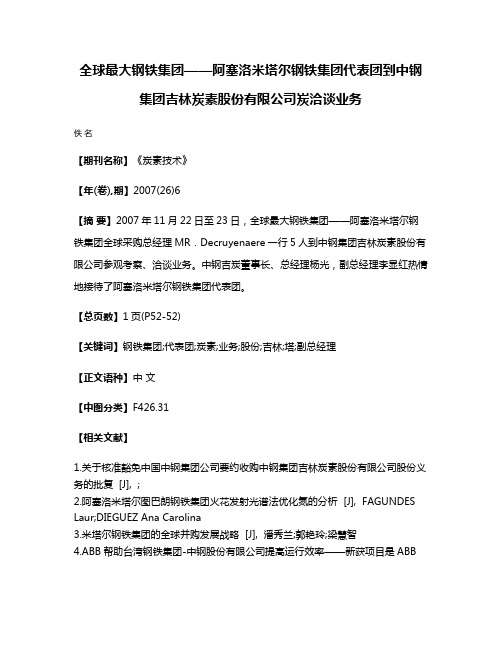
全球最大钢铁集团——阿塞洛米塔尔钢铁集团代表团到中钢集团吉林炭素股份有限公司炭洽谈业务
佚名
【期刊名称】《炭素技术》
【年(卷),期】2007(26)6
【摘要】2007年11月22日至23日,全球最大钢铁集团——阿塞洛米塔尔钢铁集团全球采购总经理MR.Decruyenaere一行5人到中钢集团吉林炭素股份有限公司参观考察、洽谈业务。
中钢吉炭董事长、总经理杨光,副总经理李显红热情地接待了阿塞洛米塔尔钢铁集团代表团。
【总页数】1页(P52-52)
【关键词】钢铁集团;代表团;炭素;业务;股份;吉林;塔;副总经理
【正文语种】中文
【中图分类】F426.31
【相关文献】
1.关于核准豁免中国中钢集团公司要约收购中钢集团吉林炭素股份有限公司股份义务的批复 [J], ;
2.阿塞洛米塔尔图巴朗钢铁集团火花发射光谱法优化氮的分析 [J], FAGUNDES Laur;DIEGUEZ Ana Carolina
3.米塔尔钢铁集团的全球并购发展战略 [J], 潘秀兰;郭艳玲;梁慧智
4.ABB帮助台湾钢铁集团-中钢股份有限公司提高运行效率——新获项目是ABB
中国在台湾地区获得的第一个汽轮机控制项目 [J],
5.南非阿西洛米塔尔钢铁集团改造电弧炉设备 [J],
因版权原因,仅展示原文概要,查看原文内容请购买。
《长方体与正方体的体积通用公式》(课件)-五年级下册数学人教版

长方体的体积=长×宽×高 底面积
正方体的体积=棱长×棱长×棱长
长方体(或正方体)的体积=底面积×高
V=S h
底面积
六、今天的作业
1、判断。 (1)0.2 3 =0.2×0.2×0.2。( ) (2)一个正方体棱长4分米,它的体积是:4 × 3 =12(立方分米)( ) (3)一个长方体,长5分米,宽4分米,高3厘米,它的体积是60分米 。( )
长方体和正方体
长方体与正方体体积的统一计算公式
学习目标:
掌握长方体与正方体体积的统一计算公式。 课本第31页。
一、复习导入
长方体与正方体的体积
1、长方体的体积=长×宽×高
V=a b h
2、正方体的体积=棱长×棱长×棱长
V=a3
3、“a3”,读作“a的立方”,表示3个a相乘。
二、探索新知 长方体或正方体底面的面积叫做底面积。
V=S h
三、巩固练习
一块长方体铝块,体积是1200平方厘米,横截面 面积是80平方厘米,这块铝块的长是多少厘米?
长方体的体积=底面积×高
高=长方体的体积÷底面积 1200÷80=15(厘米) 答:这块铝块的长是15厘米。
80平方厘米
三、巩固练习
一段长方体木料长2m,现沿横截面把它切成两节,表面积 增加了62.8cm²。这段木料的体积是多少立方分米?
底面
底面
长方体和正方体的底面积怎样求呢?
二、探索新知
底面
底面
长方体的体积=长×宽×高
底面积
正方体的体积=棱长×棱长×棱长
底面积
长方体(或正方体)的体积=底面积×高
二、探索新知
所以,长方体和正方体的体积也可以这样 来计算:
激光焊接工艺调研报告

激光焊接工艺调研报告引言21世纪是现代科技高速发展的时代,而激光技术作为目前时代发展中人们所最为瞩目的可击之一,其不仅仅是应用于现代军事领域,同样随着激光技术的日益娴熟以及其本身的制造工艺和应用工艺的普遍化,未来能够在更多的行业得到广泛应用,其中就包括传统制造业。
由于传统焊接本身更多是依赖于焊接人员自身的工作经验以及对于焊接目标的目测实现焊接,其往往精度存在一定的偏差性,很难实现高精度项目的作业,而激光焊接无疑能够有效解决这一难题,利用激光技术准确对现有的目标进行准确的焊接,从而大大提升了焊接的准确性和有效性。
未来随着工业现代化的迅猛发展,激光焊接技术有着广阔的应用空间。
鉴于此,本文主要通过对激光焊接技术的内涵以及分类出发,就目前国内外激光焊接技术研究现状进行综合性、系统性的分析,并由此结合未来制造业发展需求以及激光焊接的特点,对其未来的应用以及发展进行展望。
发展历程世界上的第一个激光束于1960年利用闪光灯泡激发红宝石晶粒所产生,因受限于晶体的热容量,只能产生很短暂的脉冲光束且频率很低。
虽然瞬间脉冲峰值能量可高达10^6瓦,但仍属于低能量输出。
使用钕(ND)为激发元素的钇铝石榴石晶棒(Nd:YAG)可产生1---8KW的连续单一波长光束。
YAG激光,波长为1.06uM,可以通过柔性光纤连接到激光加工头,设备布局灵活,适用焊接厚度0.5-6mm。
使用CO2为激发物的CO2激光(波长10.6uM),输出能量可达25KW,可做出2mm板厚单道全渗透焊接,工业界已广泛用于金属的加工上。
20世纪80年代中期,激光焊接作为新技术在欧洲、美国、日本得到了广泛的关注。
1985年德国蒂森钢铁公司与德国大众汽车公司合作,在Audi100车身上成功采用了全球第一块激光拼焊板。
90年代欧洲、北美、日本各大汽车生产厂开始在车身制造中大规模使用激光拼焊板技术。
无论实验室还是汽车制造厂的实践经验,均证明了拼焊板可以成功地应用于汽车车身的制造。
阿赛洛并购莱钢的原因
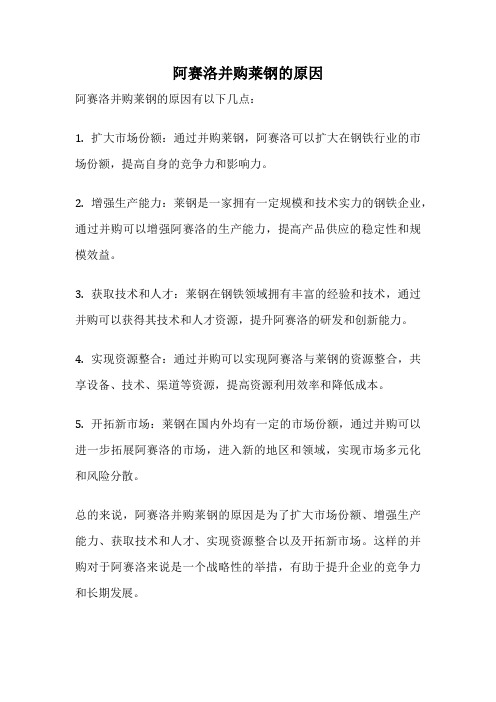
阿赛洛并购莱钢的原因
阿赛洛并购莱钢的原因有以下几点:
1. 扩大市场份额:通过并购莱钢,阿赛洛可以扩大在钢铁行业的市场份额,提高自身的竞争力和影响力。
2. 增强生产能力:莱钢是一家拥有一定规模和技术实力的钢铁企业,通过并购可以增强阿赛洛的生产能力,提高产品供应的稳定性和规模效益。
3. 获取技术和人才:莱钢在钢铁领域拥有丰富的经验和技术,通过并购可以获得其技术和人才资源,提升阿赛洛的研发和创新能力。
4. 实现资源整合:通过并购可以实现阿赛洛与莱钢的资源整合,共享设备、技术、渠道等资源,提高资源利用效率和降低成本。
5. 开拓新市场:莱钢在国内外均有一定的市场份额,通过并购可以进一步拓展阿赛洛的市场,进入新的地区和领域,实现市场多元化和风险分散。
总的来说,阿赛洛并购莱钢的原因是为了扩大市场份额、增强生产能力、获取技术和人才、实现资源整合以及开拓新市场。
这样的并购对于阿赛洛来说是一个战略性的举措,有助于提升企业的竞争力和长期发展。
阿赛洛建筑钢材技术交流会召开
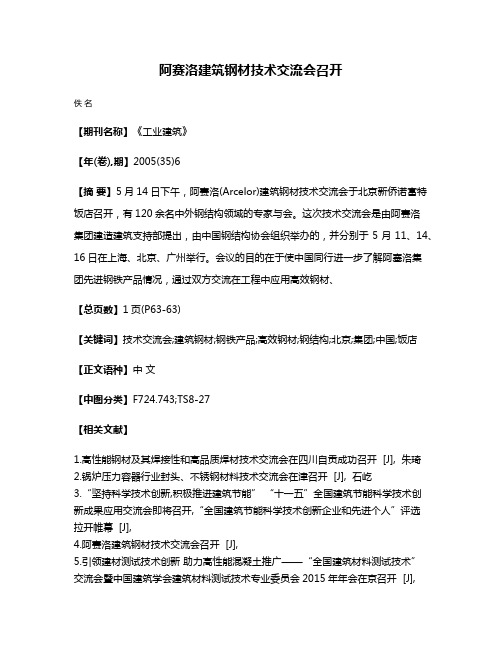
阿赛洛建筑钢材技术交流会召开
佚名
【期刊名称】《工业建筑》
【年(卷),期】2005(35)6
【摘要】5月14日下午,阿赛洛(Arcelor)建筑钢材技术交流会于北京新侨诺富特饭店召开,有120余名中外钢结构领域的专家与会。
这次技术交流会是由阿赛洛
集团建造建筑支持部提出,由中国钢结构协会组织举办的,并分别于5月11、14、16日在上海、北京、广州举行。
会议的目的在于使中国同行进一步了解阿塞洛集
团先进钢铁产品情况,通过双方交流在工程中应用高效钢材、
【总页数】1页(P63-63)
【关键词】技术交流会;建筑钢材;钢铁产品;高效钢材;钢结构;北京;集团;中国;饭店【正文语种】中文
【中图分类】F724.743;TS8-27
【相关文献】
1.高性能钢材及其焊接性和高品质焊材技术交流会在四川自贡成功召开 [J], 朱琦
2.锅炉压力容器行业封头、不锈钢材料技术交流会在津召开 [J], 石屹
3.“坚持科学技术创新,积极推进建筑节能” “十一五”全国建筑节能科学技术创
新成果应用交流会即将召开,“全国建筑节能科学技术创新企业和先进个人”评选
拉开帷幕 [J],
4.阿赛洛建筑钢材技术交流会召开 [J],
5.引领建材测试技术创新助力高性能混凝土推广——“全国建筑材料测试技术”
交流会暨中国建筑学会建筑材料测试技术专业委员会2015年年会在京召开 [J],
因版权原因,仅展示原文概要,查看原文内容请购买。
正交异性桥面板
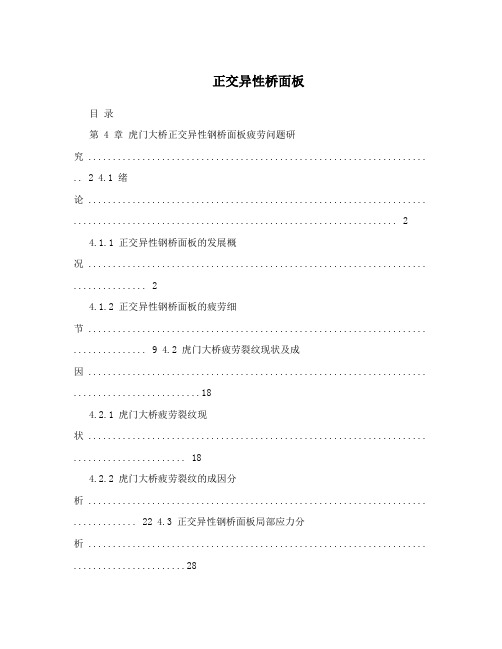
正交异性桥面板目录第 4 章虎门大桥正交异性钢桥面板疲劳问题研究 ..................................................................... .. 2 4.1 绪论 ..................................................................... (2)4.1.1 正交异性钢桥面板的发展概况 ..................................................................... (2)4.1.2 正交异性钢桥面板的疲劳细节 ..................................................................... ............... 9 4.2 虎门大桥疲劳裂纹现状及成因 ..................................................................... .. (18)4.2.1 虎门大桥疲劳裂纹现状 ..................................................................... .. (18)4.2.2 虎门大桥疲劳裂纹的成因分析 ..................................................................... ............. 22 4.3 正交异性钢桥面板局部应力分析 ..................................................................... .. (28)4.3.1 有限元分析模型 ..................................................................... . (28)4.3.2 单轮荷载作用下桥面板应力分布 ..................................................................... (30)4.3.3 跨中加载时横隔板处应力分析 ..................................................................... . (33)4.3.4 轮压荷载接触面积的影响分析 ..................................................................... . (33)4.3.5 双轴作用下桥面板应力分布...................................................................... .. (34)4.3.6 结论 ..................................................................... ................................................... 35 4.4 正交异性钢桥面疲劳裂纹加固方法研究 ..................................................................... (36)4.4.1 桥面疲劳裂缝的位置和形式 ..................................................................... . (36)4.4.2桥面疲劳裂纹加固的方法...................................................................... .. (37)4.4.3实际加固案例 ..................................................................... .. (39)4.4.4结论 ..................................................................... .................................................... 43 4.5 正交异性钢桥面板构造细节疲劳强度的研究 ..................................................................... .. (44)4.5.1 概述 ..................................................................... (44)4.5.2 焊接连接的疲劳评估 ..................................................................... (45)5.5.3 欧洲规范3有关疲劳强度规定 ..................................................................... . (47)4.5.4 肋板与桥面板的焊接连接的疲劳试验研究 (52)4.5.5 肋板与桥面板的焊接连接的试验数据统计分析 (61)4.5.6 结论 ..................................................................... ................................................... 65 4.6 小结 ..................................................................... .. (65)参考文献 ..................................................................... . (66)第 4 章虎门大桥正交异性钢桥面板疲劳问题研究 4.1 绪论4.1.1 正交异性钢桥面板的发展概况由于二战以后,德国钢材短缺,为节省材料,德国工程师建桥时采用了正交异性钢桥面板。
《法国,米洛大桥》课件

影响
文化上的重要性
米洛大桥成为了法国南部的一个标志性建筑, 也是世界建筑史上的杰出之作。
对建筑和工程学的影响
米洛桥的建造方法激励了其他工程师和建筑师 不断提高自己的技能,助推了结构工程学和材 料科学领域的发展。
结论
建筑壮观
米洛大桥巧妙地创造了举世瞩目的结构,成为人类 智慧的结晶。
历史悠久
米洛大桥见证了法国的历史,并对未来的交通工程 和桥梁建设造成了深远影响。
桥梁结构
建造材料
大部分使用高强度混凝土
建造原理
斜拉桥和悬索桥相结合,从而形 成轻巧而优美的设计
桥梁结构图
由亚麻臂形桁架结构构成,桥面 由钢筋混凝土板铺成。
历史事件
1
第一次世界大战中的米洛大桥
当时的米洛桥是一座可拆卸的钢桥,曾被用于在前线运输物资和士兵。
2
第二次世界大战中的米洛大桥
在二战中,盟军在桥梁附近的山丘上布置了大炮,炮火打击下导致桥梁被炸毁。
出游建议
前往泰纳河谷尽头的米洛镇,欣赏大桥的壮丽与杰出之处。
参考文献
1. Millau Bridge: Design 2. Millau Bridge: Construction 3. Millau Bridge: History
图片来源
1. Unsplash 2. Pixabay 3. Getty Images
《法国,米洛大桥》PPT课 件
米洛大桥是一座位于法国南部的斜拉桥,被誉为世界上最为优美的桥梁之一。 本课件将为您带来详细的介绍,了解它的历史和设计。
米洛大桥简介
1 位置
位于法国南部,横跨泰纳河谷。
2 建筑高度
考虑到旁边的山峰高度,桥梁居高不下,高度超过1000英尺。
英文论文报告参考文献格式

英文论文报告参考文献格式用Times New Roman.每一条目顶格,如某一条目超过一行,从第二行起“悬挂缩进”2字符。
参考文献中所有标点与符号均在英文状态下输入,标点符号后空一格。
参考条目顺序:英国文学、中国文学、网络文学。
他们是按姓氏的字母顺序排列的。
文件前不使用序列号。
1)英文参考文献:(1)专著与编著排列顺序为:姓、名、专有名称、出版地、出版社、出版年份。
例如:Brinkleyork: Knopf, 1993.如果名著中有其他作品或书名,则后者为斜体。
例如:Dunn, Richard J ed. Charlotte Bront: Jane EyreNew York: Norton, 1971.A、两个至三个第一的姓在前,名在后,中间用逗号隔开;其余名在前,姓在后,中间无逗号;每个之间用逗号隔开,最后一个的姓名前用“and”,后用句号。
例如:B、三个以上第一姓名(姓在前,名在后,中间加逗号)后接“et al.”,其他姓名省略。
例如:University of Hawaii Press, 1997.C、同一同一年出版的不同文献,参照下例:Widdowson, Henry G1998a.Widdowson, Henry G. Cambridge:Cambridge University Press, 1998b.(2)论文集参照下例:Thompson, Pett. “Modal Verbs in Academic Writing”. In Ben Kettlemann & York: Rodopi, 2002: 305-323.(3)百科全书等参考文献参照下例:Fagan, Jeffrey. “Gangs and Drugs”. ork: Macmillan, 2001.(4)学术期刊论文参照下例:Murphy, Karen. “Meaningful Connections: Using Technology in Primary Classrooms”.(5)网络文献参照下例:“Everything You Ever Wanted to Know About URL”.(6)专著:参照下例:皮亚杰.结构主义[M] .北京:商务印书馆,1984.(7)期刊文章:参照下例:杨忠,张韶杰.认知语音学中的类典型论[J].外语教学与研究,1999,(2):1-3.(8)学位论文参照下例:梁佳.大学英语四、六级测试试题现状的理论分析与问题研究[D].湖南大学,2002.(9)论文集参照下例:许小纯.含义和话语结构[A].李红儒.外国语言与文学研究[C].哈尔滨:黑龙江人民出版社,1999:5-7.(10)附录2)中文参考文献一、参考文献的类型参考文献(即引文出处)的类型以单字母方式标识,具体如下:[M]--专着,着作[C]--论文集(一般指会议发表的论文续集,及一些专题论文集,如《***大学研究生学术论文集》[N]-- 报纸文章[J]--期刊文章:发表在期刊上的论文,尽管有时我们看到的是从网上下载的(如知网),但它也是发表在期刊上的,你看到的电子期刊仅是其电子版[D]--学位论文 :不区分硕士还是博士论文[R]--报告:一般在标题中会有“关于****的.报告”字样[S]-- 标准[P]--专利[A]--文章:很少用,主要是不属于以上类型的文章[Z]--对于不属于上述的文献类型,可用字母“Z”标识,但这种情况非常少见常用的电子文献及载体类型标识:[DB/OL] --联机网上数据(database online)[DB/MT] --磁带数据库(database on magnetic tape)[M/CD] --光盘图书(monograph on CDROM)[CP/DK] --磁盘软件(puter program on disk)[J/OL] --网上期刊(serial online)[EB/OL] --网上电子公告(electronic bulletin board online)很显然,标识的就是该资源的英文缩写,/前面表示类型,/后面表示资源的载体,如OL表示在线资源。
第3讲 供应链网络规划

25
4)选址及产能分配
l 定量决策、定量模型、算法 l 产能? ü 生产性设施:产品种类及其生产/供给能力; ü 存储性设施:货物存储量和吞吐量; ü 销售点/零售店:销售产品的种类及其数量。
26
3.3 供应链网络规划设计过程
p 如何设计一个最佳的网络? 多少个仓库?仓库储存品种?仓库地理位置? • 考虑生产工厂和采购点的位置分布 • 客户分布、哪些客户订购了哪些产品、订购批量… • 配送成本的考虑 • 配送网络的规划将如何影响客户服务水平? • 优化软件工具的使用
p 案例启示?
5
u 供应链网络规划任务
6
u 供应链网络规划任务
p 任务要求: 从潜在的地址中选出最合理的设施位置,使供应链网络的总 成本最小或最满意。
30
供应链网络的总成本由哪几部分构成?
SC网络总成本 本
设施运营成本
设施建设成
运输成本、库存成本、生产成本、仓储作业成本 ……
• 构成成本之间的二律背反(trade-off) • 总成本最小化
31
两种网络结构情形
28
3.4 供应链网络规划典型问题描述
p网络规划问题的一般性 描述 p 网络规划问题举例
29
3.4 供应链网络规划典型问题描述
u 供应链网络规划问题的一般性描述
p 已知: - 某公司在一定区域内分布着一定数量的设施; - 特定区域对公司供应的不同产品有不同需求, - 各设施点生产能力(或配送能力)已知。 - 已初步选出了一组潜在的设施位置。
5
W1 4
3
C1
3 20 000 件
钢结构智慧树知到课后章节答案2023年下陕西工业职业技术学院

钢结构智慧树知到课后章节答案2023年下陕西工业职业技术学院陕西工业职业技术学院绪论单元测试1.采用高强度的钢材,对大跨度、高耸、重型结构非常有利,可有效地减轻结构自重。
()A:错 B:对答案:对2.在古代钢结构多用于桥跟铁塔,汉代云南景东地区的兰津桥,是世界上最早的一座铁索桥。
()A:对 B:错答案:对3.1996年我国的钢产量超过一亿吨,2016年达到11亿吨。
成为世界第一产钢大国。
()A:错 B:对答案:对4.钢管混凝土属于钢结构,能够充分发挥两种材料地长处,又互相弥补对方地缺点。
()A:对 B:错答案:错5.在国家体育场—“鸟巢”建设中,当钢板厚度为100~110mm时,采用(),具有良好的抗震性、抗低温性和可焊性等优点。
A:Q460E—Z35钢 B:Q345GJD钢 C:Q345钢 D:Q235钢答案:Q460E—Z35钢6.钢结构具有塑性和韧性好的特点,主要用于()。
A:大跨度结构 B:轻型钢结构 C:直接承受动力荷载作用的结构 D:高耸结构和高层建筑答案:直接承受动力荷载作用的结构7.在重型工业厂房中,采用钢结构是因为它具有()的特点。
A:匀质等向体、塑性和韧性好 B:可焊性、耐热性好 C:匀质等向体、轻质高强 D:轻质高强、塑性和韧性好答案:轻质高强、塑性和韧性好8.钢结构一般不会因偶然超载或局部超载而突然断裂破坏,这是由于钢材具有()。
A:均匀的内部组织 B:良好的韧性 C:良好的塑性 D:良好的塑性答案:良好的塑性9.钢结构的主要缺点是()A:施工困难多 B:结构的重量大 C:造价高 D:易腐蚀、不耐火答案:易腐蚀、不耐火10.大跨度结构常采用钢结构的主要原因是钢结构()A:制造工厂化 B:密封性好 C:自重轻 D:便于拆装答案:自重轻11.若结构是失效的,则结构的功能函数应满足()。
A:Z<0 B:Z˃0 C:Z≥0 D:Z=0答案:Z<012.当结构或其组成部分超过某一特定状态就不能满足设计规定的某一功能要求时,此特定状态称为该功能的极限状态。
法国IGE公司简介

合作者
R&D部门与解决方案部门 159 人 (统计于2006年7月31日)
组织结构
CONFIDENTIAL – This document is the property of IGE+XAO and shall not be communicated without its consent
线束设计 战略概览
我们的客户
Legrand(罗格朗国际电工有限公司), Bouygues(法国布依格集团-电信工程), Bosch(博世), Kodak(柯达),
Schlumberger(美国斯伦贝谢公司),
Carrier(美国开利 )
CONFIDENTIAL – This document is the property of IGE+XAO and shall not be communicated without its consent
CONFIDENTIAL – This document is the property of IGE+XAO and shall not be communicated without its consent
选择我们的理由
面临的挑战 • 工程师设计无法一致 • 需要很多的重复设计
西安飞机工业集团公司
我们的客户
空中客车, (航空) 巴西航空, (航空) Thales(泰雷兹公司 -军事电子), Northrop Grumman(美国诺斯洛普格拉曼公司 -舰载雷达),
Socata(索卡塔公司 -轻型飞机),
Air France-KLM(法航-荷航公司 -航空) ,
CONFIDENTIAL – This document is the property of IGE+XAO and shall not be communicated without its consent
罗赛洛为明胶生产树立榜样——访罗赛洛集团亚太区总裁刘刚
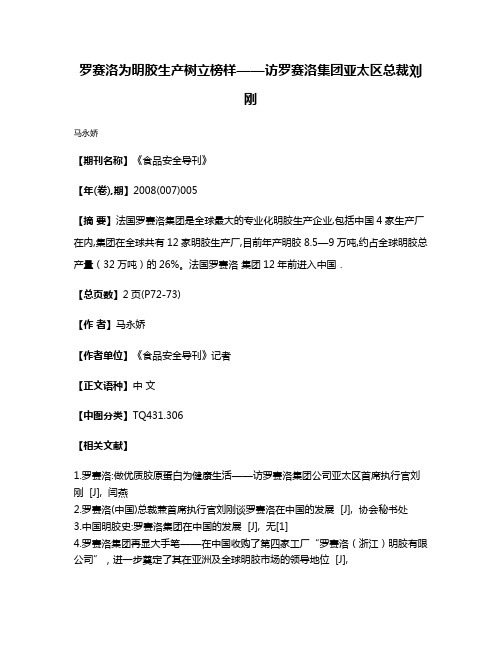
罗赛洛为明胶生产树立榜样——访罗赛洛集团亚太区总裁刘
刚
马永娇
【期刊名称】《食品安全导刊》
【年(卷),期】2008(007)005
【摘要】法国罗赛洛集团是全球最大的专业化明胶生产企业,包括中国4家生产厂在内,集团在全球共有12家明胶生产厂,目前年产明胶8.5—9万吨,约占全球明胶总产量(32万吨)的26%。
法国罗赛洛集团12年前进入中国.
【总页数】2页(P72-73)
【作者】马永娇
【作者单位】《食品安全导刊》记者
【正文语种】中文
【中图分类】TQ431.306
【相关文献】
1.罗赛洛:做优质胶原蛋白为健康生活——访罗赛洛集团公司亚太区首席执行官刘刚 [J], 闫燕
2.罗赛洛(中国)总裁兼首席执行官刘刚谈罗赛洛在中国的发展 [J], 协会秘书处
3.中国明胶史:罗赛洛集团在中国的发展 [J], 无[1]
4.罗赛洛集团再显大手笔——在中国收购了第四家工厂“罗赛洛(浙江)明胶有限公司”,进一步奠定了其在亚洲及全球明胶市场的领导地位 [J],
5.罗赛洛集团在中国收购了第三家工厂——罗赛洛(大安)明胶有限公司进一步奠定了其在亚洲明胶市场的领导地位 [J],
因版权原因,仅展示原文概要,查看原文内容请购买。
法国昂特那斯钢管拱桥
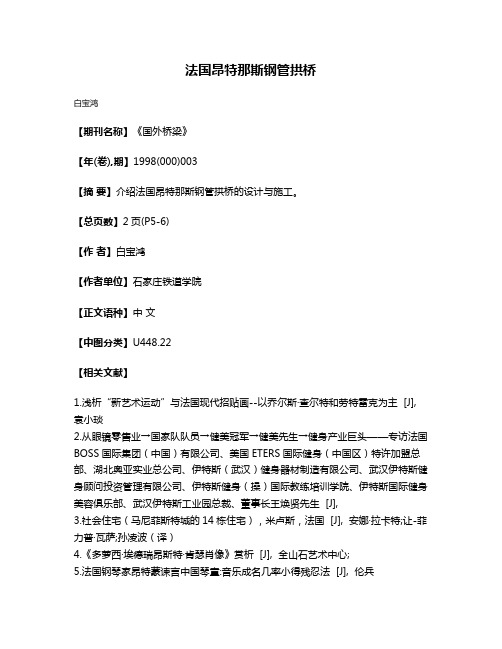
法国昂特那斯钢管拱桥
白宝鸿
【期刊名称】《国外桥梁》
【年(卷),期】1998(000)003
【摘要】介绍法国昂特那斯钢管拱桥的设计与施工。
【总页数】2页(P5-6)
【作者】白宝鸿
【作者单位】石家庄铁道学院
【正文语种】中文
【中图分类】U448.22
【相关文献】
1.浅析“新艺术运动”与法国现代招贴画--以乔尔斯·查尔特和劳特雷克为主 [J], 袁小琰
2.从眼镜零售业→国家队队员→健美冠军→健美先生→健身产业巨头——专访法国BOSS国际集团(中国)有限公司、美国ETERS国际健身(中国区)特许加盟总部、湖北奥亚实业总公司、伊特斯(武汉)健身器材制造有限公司、武汉伊特斯健身顾问投资管理有限公司、伊特斯健身(操)国际教练培训学院、伊特斯国际健身美容俱乐部、武汉伊特斯工业园总裁、董事长王焕贤先生 [J],
3.社会住宅(马尼菲斯特城的14栋住宅),米卢斯,法国 [J], 安娜·拉卡特;让-菲力普·瓦萨;孙凌波(译)
4.《多萝西·埃德瑞昂斯特·肯瑟肖像》赏析 [J], 全山石艺术中心;
5.法国钢琴家昂特蒙谏言中国琴童:音乐成名几率小得残忍法 [J], 伦兵
因版权原因,仅展示原文概要,查看原文内容请购买。
法国米高(Millau)大桥设计与施工简介
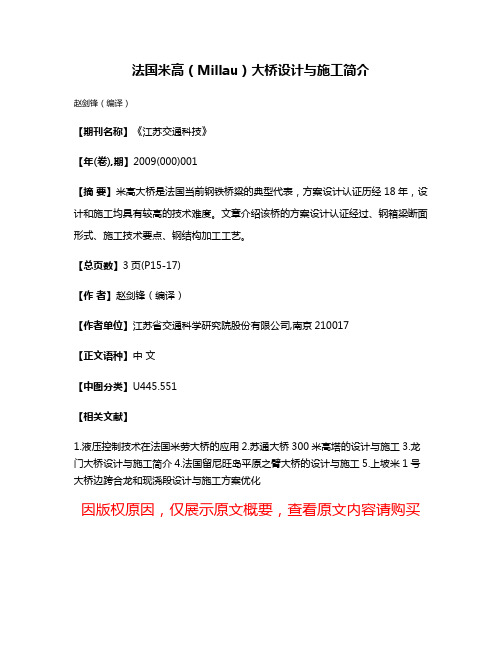
法国米高(Millau)大桥设计与施工简介
赵剑锋(编译)
【期刊名称】《江苏交通科技》
【年(卷),期】2009(000)001
【摘要】米高大桥是法国当前钢铁桥粱的典型代表,方案设计认证历经18年,设计和施工均具有较高的技术难度。
文章介绍该桥的方案设计认证经过、钢箱梁断面形式、施工技术要点、钢结构加工工艺。
【总页数】3页(P15-17)
【作者】赵剑锋(编译)
【作者单位】江苏省交通科学研究院股份有限公司,南京210017
【正文语种】中文
【中图分类】U445.551
【相关文献】
1.液压控制技术在法国米劳大桥的应用
2.苏通大桥300米高塔的设计与施工
3.龙门大桥设计与施工简介
4.法国留尼旺岛平原之臂大桥的设计与施工
5.上坡米1号大桥边跨合龙和现浇段设计与施工方案优化
因版权原因,仅展示原文概要,查看原文内容请购买。
中国钢铁工业协会(CISA)访问卢森堡
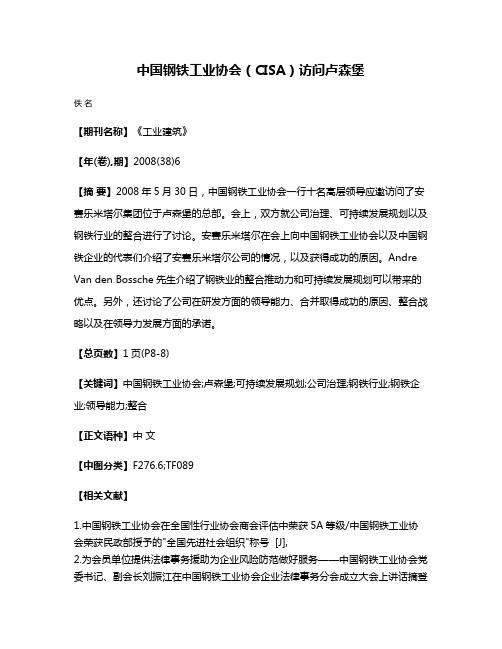
中国钢铁工业协会(CISA)访问卢森堡佚名【期刊名称】《工业建筑》【年(卷),期】2008(38)6【摘要】2008年5月30日,中国钢铁工业协会一行十名高层领导应邀访问了安赛乐米塔尔集团位于卢森堡的总部。
会上,双方就公司治理、可持续发展规划以及钢铁行业的整合进行了讨论。
安赛乐米塔尔在会上向中国钢铁工业协会以及中国钢铁企业的代表们介绍了安赛乐米塔尔公司的情况,以及获得成功的原因。
Andre Van den Bossche先生介绍了钢铁业的整合推动力和可持续发展规划可以带来的优点。
另外,还讨论了公司在研发方面的领导能力、合并取得成功的原因、整合战略以及在领导力发展方面的承诺。
【总页数】1页(P8-8)【关键词】中国钢铁工业协会;卢森堡;可持续发展规划;公司治理;钢铁行业;钢铁企业;领导能力;整合【正文语种】中文【中图分类】F276.6;TF089【相关文献】1.中国钢铁工业协会在全国性行业协会商会评估中荣获5A等级/中国钢铁工业协会荣获民政部授予的"全国先进社会组织"称号 [J],2.为会员单位提供法律事务援助为企业风险防范做好服务——中国钢铁工业协会党委书记、副会长刘振江在中国钢铁工业协会企业法律事务分会成立大会上讲话摘登[J],3.中国钢铁工业协会关于调整副会长的决定/中国钢铁工业协会关于调整部分理事、常务理事的决定/中国钢铁工业协会关于吸收新会员的决定/中国钢铁工业协会关于印发《关于加强冶金企业计量工作的意见》的通知 [J],4.中国钢铁工业协会关于吸收新会员的通报/中国钢铁工业协会关于同意天津市中山钢业有限公司、吉林省冶金工业协会筹委会不再作为会员单位的意见/中国钢铁工业协会关于对河北滦河实业集团有限公司、天津无缝钢管厂按自动退会处理的决定/中国钢铁工业协会关于调整部分理事、常务理事的通报 [J],5.中国钢铁工业协会财务与价格工作委员会主任委员、常务副主任委员、副主任委员、执行秘书名单/中国钢铁工业协会财务与价格工作委员会执行委员(单位)名单/中国钢铁工业协会财务与价格工作委员会委员(单位)名单 [J],因版权原因,仅展示原文概要,查看原文内容请购买。
- 1、下载文档前请自行甄别文档内容的完整性,平台不提供额外的编辑、内容补充、找答案等附加服务。
- 2、"仅部分预览"的文档,不可在线预览部分如存在完整性等问题,可反馈申请退款(可完整预览的文档不适用该条件!)。
- 3、如文档侵犯您的权益,请联系客服反馈,我们会尽快为您处理(人工客服工作时间:9:00-18:30)。
New trends in Steel Bridge Design and Construction in FranceDr Wasoodev HOORPAHCivil EngineerHead of Bridges Dept.OTUA, Paris, FRANCESummarySteel has gradually made a come-back in the deck structure of medium and long span bridges in France in the last twenty-five years. This trend started in the road bridges first and has now reached the maximum share in the bridges for the new high-speed railway lines. Along with economical structures like the twin girder decks, steel has kept on being used in innovative and technically challenging design. This paper shows the recent trends and the new markets in bridge design with steel taking place now in France.Keywords: Steel, composite, aesthetics, high-speed railways, twin girder, tied arch, double box section, construction, launching.1. IntroductionNowadays in France, above 80 % of bridges in the medium and long span range have a composite steel concrete deck. This trend started in the 1980’s in the road bridges. Before that in the 1970’s the development of prestressed concrete bridges in France had totally excluded steel from the bridge market.About ten years later, the same phenomenon was observed in the rail bridges for the high-speed lines. The first two lines in the 1990’s had only pre-stressed concrete viaducts, but the share of steel has gradually been increasing since that time.The comeback started with the twin girder composite decks and gradually gave birth to other types of structures. The new trends with steel can now be observed in all span ranges.2. The come back of steel in bridgesSteel for bridges is not an important market in France, the annual structural steel weight in this construction branch bridges varies between 30 and 40 thousand tonnes. Bridges however provide a highly mediatic image for steel and the steel industry is keen to promote this image. Although the total weight remains nearly the same, the percentage of deck surface in the medium and large bridges has been constantly rising since the 1970’s. In these lest years, major bridge projects are being built with steel both for motorways and high-speed railways.This comeback is due to the special research and development efforts of all the professionals involved in the steel bridges: owners, designers, builders, steel fabricators. The most important of these relate to the design of uncomplicated structures, the use of modern calculation rules based on the limit states concept and the availability of high quality thick steel plates.The French Steel Bridges Committee has also played an important role in the development of the steel bridge market. Since the early 1980s, for large and medium bridges a double tender has been made as often as possible, with two alternatives: prestressed concrete and steel-concrete composite deck. Professional training programmes have also been organised regularly to familiarise the design engineers with steel and composite bridges.Statistics of road bridges shows that a single type of structure accounts for the success of steel bridges: the twin girder composite bridge. This structural type accounts for over 80 % of new bridges. The economic advantage of the twin girder deck was first demonstrated in the motorway bridges. For this reason the French Railways with the help of the steel bridges constructors and the steel fabricators carried research programs and proved the competitiveness of these decks for the new railway bridges.102030405060708090100020406080100Fig. 1 : Market share of composite bridges with span length3. Road bridges3.1 Twin girder deckThe most common type of structure is the twin girder composite deck which consists of a reinforced concrete slab which is connected to two steel beams. The typical roadway widths correspond to two or three lanes. The main beams are cross braced by I -girders every 6 or 8 metres ( figure 1).These cross girders are welded to T -shaped vertical stiffeners. These structures are usually entirely welded by fillet welds, with the exception of the temporary wind bracing which is used during construction before the concrete slab is placed and which is assembled using bolts.The slab is generally connected by four rows of studs. Welded segments of angles have occasionally been used.Fig. 2 : Common twin girder composite deckThis basic form has undergone different variations : For very wide decks the slab is also supported by the composite cross girders whose upper flanges are welded to the upper surface of the main girders and these cross-girders sometimes extend under the cantilever parts of the deck as well.Though this structure appears simple, it nevertheless incorporates the latest developpments from the steel manufacturers :- very thick plates reaching 150 mm, thus without flanges consisting of plates welded ontop of each other;- longitudinally profiled plates, which alllows an optimal tailoring to the bending momentdiagram; ( Fig. 3)-thermomechanical steel with a better weldability, not requiring preheating on site.To enhance the aesthetic of the bridge, it is quite common to have girders of variable depth, especially for long spans reaching 100 meters. The launching of such decks is possible, though a bit more complicated than the constant depth girders.3.2 Box sectionsFor geometrically complicated bridges: curved or skew for example, it is usual to have a box section necessary to resist torsional effects. The most common shape is a trapezoidal form. In some cases the upper flange provides the closed section, but the open box with two upper narrow flanges is cheaper to fabricate and the slab concreting can be also easier.The aesthetics of these sections are highly appreciated by bridge owners; for this reason they have been chosen even for medium span crossings where the twin girders could have been economical.For large decks, up to now the cantilever on the outside was supported by crossbeams in the alignment of the diaphragms. The recent examples of Verrières and Valence viaducts have introduced diagonal tubular bracings which can also be inclined longitudinally. ( Fig.4)Fig. 4 : Box sections with tubular brackets3.3 Special composite bridgesConcrete bridge designers often find it interesting to use steel webs, for lightness and specially for construction ease. For the 240 m. span Bras de la Plaine bridge opened in 2002 in Réunion island, the deck consists of two prestressed concrete flanges connected to vertical tubes. These were essential for the cantilever construction of the deck. Additional external prestressing cables are also present .Fig. 5 : Viaduct of Bras de la Plaine in RéunionIn the Meaux viaduct near Paris, the box section has the upper and lower flanges in prestressed concrete and two ‘plano-tubular webs’ with additional tubular brackets. This 31 m wide bridge also has the signal span prestressed with underside cables. ( Fig. 6) This design benefited f r om a special innovation financing.Fig. 6 : Meaux Viaduct4. High speed railway bridgesThis comeback took place in the new TGV railway bridges only after 1990. The first high speed railways in the eighties: South East and Atlantic lines had only pre-stressed concrete viaducts while the North TGV line from Paris to Lille included some fifteen steel and composite bridges for a total weight of 20000 tons.This trend was confirmed in the new Mediterranean TGV with 44000 tons of steel in 23 bridges, counting for nearly two thirds of the total large crossings. This exceeds the current annual steel consumption in French bridges which reaches about 30 000 tons.4.1 The structural designSteel has played an essential role by enabling the high speed crossing of spans ranging from 25 m to over 100 m. For the longest spans above 63 meters, a warren truss girder was chosen in the TGV Nord line and tied-arch bridges for the TGV Méditérranée line; for the shorter spans plategirders decks were chosen: composite two or four beams, twin boxes or lateral girders. Table 2 shows the structural types with the total length and the steel quantities used.In the TGV Mediterranean line, the eight largest viaducts were designed with an architectural competition; among these five had a steel structure : tied arch bridges of La Garde Adhémar, Mornas, Mondragon, Bonpas and a special tubular truss at Viaduc de l’Arc.The conceptual design of steel bridges has evolved from the classical twin girder composite deck to more aesthetic tied arches. This was due of course to the increase in span length, but also to the aesthetic demands in the TGV Méditerranée crossings.1993 - 1996 1994 - 1996 1997 -1999Multi Girder 234 m 573 t 121 m 700 t 992 m 3554 tRAPL 581 m 3350 t 300 m 2000 t 245 m 2040 tWarren Truss 91 m 1000 t 0 0 0 0Twin box section 0 0 0 0 290 m 1022 tTied arch 0 0 0 0 730 m 12900 t0 0 0 0 300 m 1270 tSpecial tubulartrussTable 1 : Structural types of HSR steel bridges : total length and steel weightThe twin girder composite deck proved its highly competitive and economic value throughout all the lines.The largest span built up to now is 63 m. at Viaduc d’Orgon; span of 75 m. will be seen in the new TGV Est at Viaduc sur La Moselle. Its design has been optimised through easy to fabricate structural details especially for the lower bracing. In some bridges this bracing is replaced with concrete slabs, which are even more economical.The conceptual design was carried with special attention to the dynamic behaviour of the deck which had to be guaranteed under the high speed train. This is one of the main reason why the high speed railway steel bridges systematically incorporate a concrete slab which takes part in the global and local resistance as part of the composite deck structure. It also carries the ballast. The concrete also brings supplementary mass and damping, thus decreasing the noise emission under the TGV passing. High speed requires the steel deck to be very stiff and sufficiently heavy to limit dynamic phenomena, which have to be mastered in order to ensure the safety and comfort of the train passengers. The railway works regulations impose severe and precise criteria for these points. This also has some important consequences on the detailed design regarding the fatigue resistance.In all these bridges, particular attention was given to the integration of architectural and structural values in the engineer's work through a constant dialogue with the architect. This gave birth to the spectacular steel superstructures in the large tied-arch viaducts with complex fabrication details Mornas and Mondragon, La Garde Ahémar, South Avignon toll. And of course the Arc Viaduct with its particular tubular truss girders.In the new TGV Est line under construction, the lateral girder composite decks have been chosen for skewed crossings over the A4 motorway. For the large viaducts like the Jaulny viaduct, a composite deck on a double box sections with the outer web inclined has been chosen. This last kind of deck had been introduced in fact in the TGV Méditerranée line for short skewed crossings.5. Cable stayed bridges - The Millau Viaduct5.1 Preliminary designThe Millau viaduct under construction now will lead to the opening of an alternative to the North - South crossing of France by the A6 and A7 in the Rhone Valley. The by-pass of the town of Millau in progress now in Aveyron department has required the construction of the impressive world record high Millau Viaduct over the Tarn valley.The crossing of the Tarn valley represents a difficult obstacle for all crossings designed around Millau. Lengthy studies carried since fifteen years ago h ad first analysed the gross itineraries in order not to cut of the town from this new route, then the possible crossings of the Tarn Valley, with all the bridges and tunnels required by each route chosen. Geological conditions excluded some possibilities, also did the too steep alignments outside the motorway standards. ( Table 2)March 1988 First survey of possible routesJune 1989 Choice of « median » routeOctober 1991 Choice of the ‘’high’’ alternativeJuly 1993 Approval of preliminary design (APS)November 1993 Preliminary detailed project with 8 engineer and 8 architect teamsNovember 1994 Competition with 5 engineer-architect teams.January 1995 Official Public Interest Declaration (DUP) of Millau by-pass.July 1996 Choice of multi-span cable stayed bridge by team: FOSTER -SOGELERG -SERF - EEG .January 1998 Government decision for concession of the viaductOctober 1999 DUP of the concessionFebruary 2000 Call for bidsJuly 2000 The 4 candidates are accepted for the competitionDecember 2000 Return of the bid offer by 3 candidatesFebruary 2001 Choice of Eiffage group with the steel deck solutionApril 2001 End of preparatory works on siteSeptember 2001 Official government decree approving the concessionTable 2 : Preliminary design phases of the Millau ViaductThe valley is here about 2 500m large between two high points: Puech d'Ausset in the North and Puechass at the South. The deepest part, about 700m wide is over the river Tarn and is followed by the almost flat Plateau de France towards the North.As shown on Table 2, the French Government called for the competence of the French bridge engineering community to analyse all possible structural solutions for this crossing. The design teams - architects and engineers - studied various structural alternatives. For the final design phase there were six bridge types proposed : deck of constant or variable depth in steel and concrete, a large concrete arch, under-stressed truss girder and multi-span cable stayed viaduct. (Fig. 7)Fig. 7 : The different types of bridges in the initial design ( Source AIOA )For the final phase of these preliminary design steps, the following alternatives were proposed : •Pre-stressed concrete deck with spans of 175m•Steel box with orthotropic deck in 200m span•Concrete arch viaduct 500m wide.•Steel lattice deck with steel piers in 350m span•Multi-span cable stayed viaduct with pre-stressed concrete deck in current span of 350m From these proposals, an international jury led by the Road Director chose the cable-stayed bridge.5.2 Cable stayed viaductThis solution is a 2450 m long viaduct with 6 equal spans of 342m and end span of 204m. The particular mountainous configuration of the crossing imposed the pier implementations and the span distribution. A large signal span over the Tarn was not justified technically or architecturally, because this span would have been at one end of the viaduct without a global equilibrium and certainly unstable to wind loads. Besides this span would not seem logical from the different viewpoints as the Tarn crossing is never completely visibleIn this powerful landscape, the viaduct could not remain discreet; it had to mark its presence while at the same time remaining slim and elegant. The regular span distribution has a particular aesthetic aspect.Fig. 8: Photomontage of final design( Design team FOSTER-SOGELERG-EEG-SERF) ( Source AIOA)The Millau viaduct will the latest example of the new cable stayed bridge concept. Such multi span cable-stayed bridges provide an elegant solution for large valleys or strait crossing. The design of such bridges requires careful studies: an intermediate span loading causes uplift in the two adjacent spans. As there are no retaining cables from a pier on a back span or abutment, an internal stiffness must be provided within the bridge itself. This is achieved by the double pier tops and the pylon legs, which provide a rigid intermediate support. ( Fig. 9)Fig. 9 : Pier-deck-pylon junction ( Source N.FOSTER)5.3 The steel deckThe initial design was proposed with a pre-stressed concrete deck. The steel alternative had also been proposed by the client, but the unorthodox nature of the proposed construction method, led many professionals to give little chance to the steel against the concrete deck. As the in service behaviour of the two types of deck are nearly identical, the benefits of steel in the long term was put forward, for m aintenance and repair, the greater speed and reliability that industrial steel fabrication would offer, and the safety and ecological benefits of launching a fully constructed deck from the two abutments as opposed to concrete works at such a tall height finally gave an advantage to this solutionFig. 10 : Cross-section of orthotropic steel deck ( Source AIOA)The all steel deck consists of a 4m by 4.2m rectangular main box which forms the central spine of the 32m deck and whose primary function is to anchor the stay cables. The whole deck is a aerodynamic box section designed to resist the buffeting wind effects which are particularly strong at this height over the mountain valley. The upper flange of the deck is an orthotropic plate with the trapezoidal stiffeners designed to withstand also the axle loads of cars and heavy trucks on theasphalt. The corrosion protection of the inside of the box section will be obtained by the use of a drying system, which is more economical than a coating system. However the external surface of the steel deck will be protected by a classical multi layer painting system which will also give the final colour.The Millau Viaduct also demonstrates that steel pylons can be economical by reducing the work duration. The two pylons on the Tarn span will be used to retain the overhanging nose of the deck during launching, while the other pylons will be slid on the deck and upraised directly over the piers.The steel deck of Millau Viaduct will be fabricated with high performance weldable steel. Many of the steel elements such as the inner webs will have to resist complex stresses under the very high reactions during launching or the pylons and the stay cable anchorages in service. For these reasons most of the steel elements will be in S460 TM grade. On site welding of this grade can be done without pre-heating. This steel grade was first used in France in 1994 at the Remoulins Viaduct, and the Millau viaduct will be the first large scale utilisation : about 12000 tons on the total of 36000 tons. The other steel grade mainly used will be S 355.5.4 The construction methodThe Millau Viaduct has been for the specialist design teams, one of the bridges whose construction method proved to be really tough to imagine. This mountainous site rendered any construction method from the valley below quite impossible without a ballet of heavily loaded trucks hindering the local traffic. Besides the local authorities and the bridge owner were committed under the environment protection measures to limit the works nuisance. The construction method thus logically follows: the deck could only be constructed by launching the completely fabricated box section from either side of the large valley. Temporary steel lattice piers are being built between the definite concrete piers in order to cut the launching distance to half the final span, except over the deepest part of the crossing, just over the river Tarn, where the two parts will join together. ( Fig.10). The deck stability, against aerodynamic wind forces is naturally obtained with the profiled shape of the steel box.To control the end deformation of the deck during launching, this end is supported by the stay cables anchored on the end pylons. The deck will be pushed on special launching equipments called translators. It will be lifted on each support with vertical jacks, then pushed with horizontal jacks, thus translating the whole deck forward by 60cm steps. These operations carried out simultaneously on all the supports will be synchronised by computer control. In this system, contrary to a classical sliding method on neoprene pads, no longitudinal forces are injected on the pier tops. The launching will take place from one pier to the next one without intermediate stop, the deck end will thus be fixed during the stopping required to weld the deck sections at the back. As for the steel pylons reaching 90m over the deck, they will be completely assembled in the construction halls on the work platforms behind the abutments and slid horizontally on the launched deck by a special carrier on multiple wheels, then raised at their final position over the piers. For this raising, the steel contractor has designed a special rotating crane that will lift the upper end of the pylon with jacks and cables. ( Fig. 11).Fig. 12 : Some construction sequences in April 20035.5 FabricationThe foundation works have started at the beginning of 2002 on site. The steel fabrication has started at nearly the same period in the steel contractor, EIFFEL’s shops at Lauterbourg. The 36000 tons of steel which will be mounted for this viaduct represents a year’s consumption of steel in bridges in France. The inner box has web plates in thickness ranging from 40 to 90mm. The lateral parts consists of 12 and 14 mm plates with stiffeners in 6 and 8 mm cold formed trapezoidal section. The sections with an average length of 22m and breadth of 3.50m are fabricated with automatic welding machines and a welding robot. ( Fig. 12- Fig. 13)6. Conclusion7. References[ 1 ] G. LEBAILLY, B. PLU : Les ouvrages d’Art Métalliques sur LGV – JIS Dec. 2002[ 2 ] Ph. RAMONDENC : The design of the steel and composite bridges of the TGVMéditerranée. IABSE Conference , Madrid 12-14 June 2002[ 3 ] OTUA : Ponts du TGV Méditerranée - Bulletin Ponts Métalliques N° 19 - 1999 [ 4 ] OTUA : Ponts du TGV Nord - Bulletin Ponts Métalliques N° 16 – 1996[ 5 ]J. RAOUL : The design of common composite road bridges in France – ECCS Steel Bridges Symposium- Barcelona March 2003。
